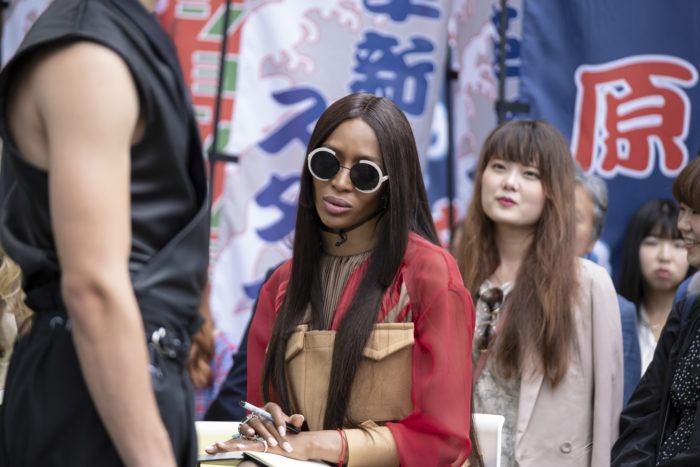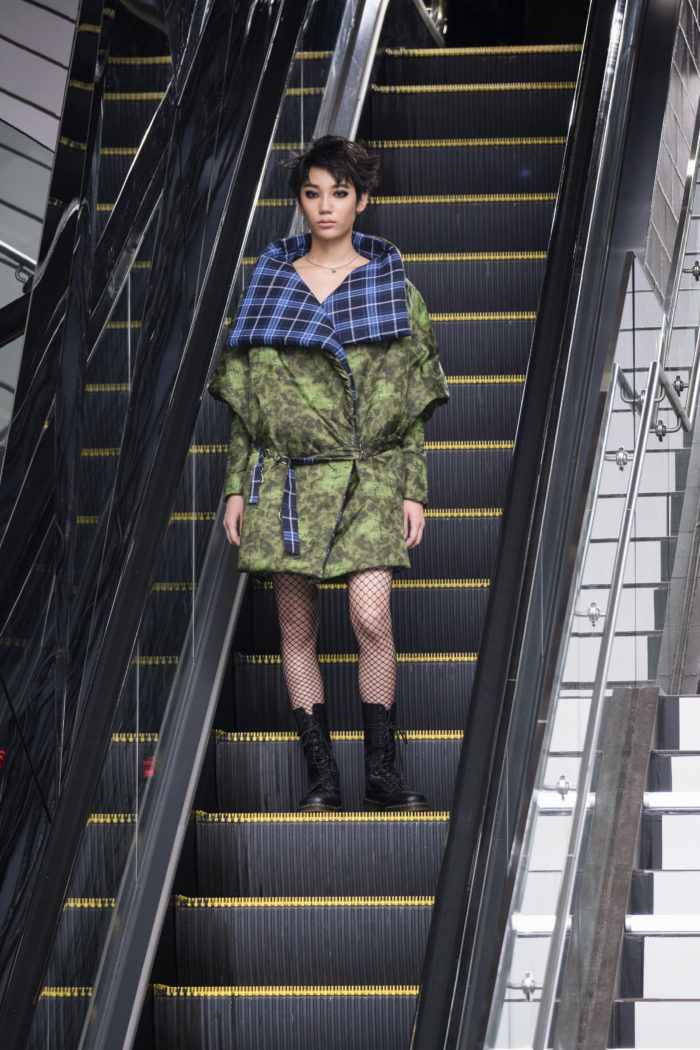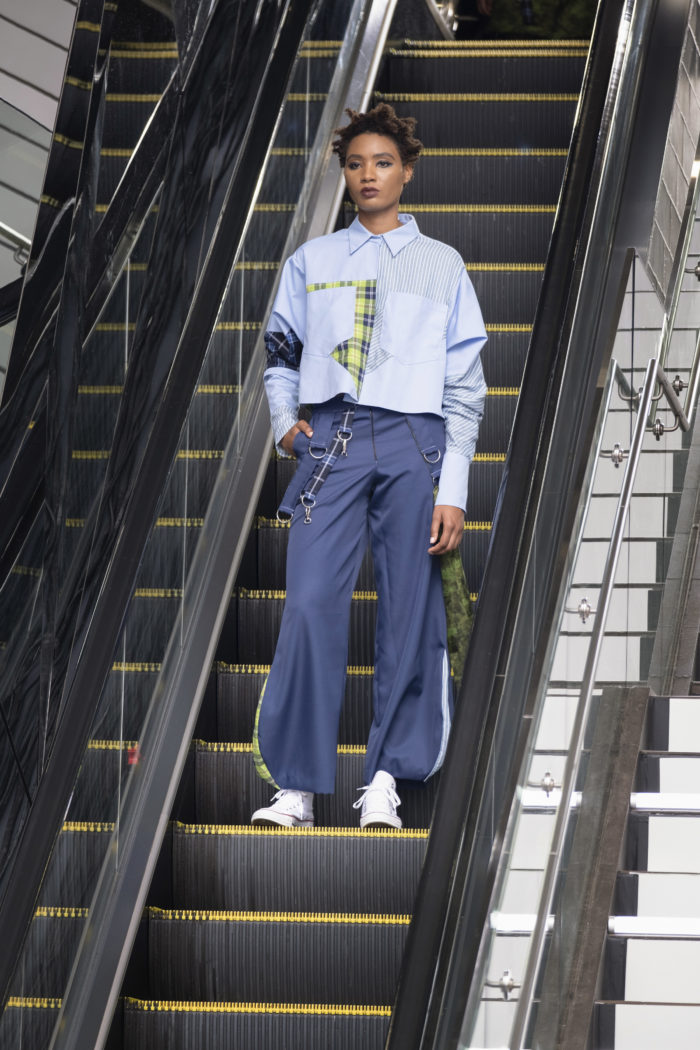
In this episode of Making the Cut, the designer contestants traveled to Tokyo for their next challenge. Mentor Tim Gunn and judge/host Heidi Klum donned their streetwear and greeted the designers in a picturesque Japanese garden to present the newest task.

The challenge
The designers were tasked with creating a two-look streetwear collection, one showstopper and one marketable interpretation of the showstopper. Their looks needed to be inspired by Harajuku street fashion. Harajuku, an area within Tokyo, is known for its culture and fashion. Japanese streetwear in particular is renowned for being experimental and diverse. This episode’s runway show was on an escalator in the famous Tokyo Plaza landmark.
Heidi and Tim introduced a new option for the contestants to design their own fabric, encouraging them to include their own logo or branding. The episode’s winner had the opportunity to create a co-branded collection with Puma, in addition to having one look sold on Amazon’s Making the Cut store.
Many of the designers struggled with jet lag or exhaustion. When it came time for Tim’s critiques, insecurities and differences of opinion emerged. Esther Perbandt kept to her all-black collection with which Tim expressed concern. However, Esther said she didn’t come on this show to compromise her brand, and she stuck with black.
Tim’s talk with Sabato Russo could be considered disastrous. Of Sabato’s two looks, Tim loved one and said the other was lacking. Sabato had the opposite opinion and decided to scrap the look Tim loved for a hastily constructed mess of a dress.
While the looks walked the runway, Tim showed supreme disappointment in Sabato for scratching the dress. I’ve never heard Tim call out a designer for not listening to his advice before, but I’ve also never seen a designer scrap something contrary to Tim’s advice. Sabato was clearly shaken by the experience.

The judging
Before the judges called any designers up for review, they had a quick note for Sander Bos. He was safe, but the judges lightly told him off for not making a salable collection.
Rinat Brodach, the first designer called up, explained that she was inspired by Japanese construction workers and hipsters. The judges had high praise for her gender-neutral designs and fun looks. They noted that they still did not have a clear idea of who she was as a designer. However, they made her the winner of this challenge.


Jonny Cota was next. This challenge was right up his alley, as most of his looks have a streetwear vibe. The judges praised him for his silk organza hoodie over a printed top and cargo pants, and they admired the print he designed. He made the cut.
Then Esther stood before the judges. They were surprised to hear she went to the Harajuku Kawaii Monster Café for inspiration because her all-black collection reflected none of the cafe’s crazy color. They loved her looks, however, and encouraged her to consider using color in the future. She made the cut.
Finally, Sabato came forward. He struggled with this challenge. Tim mentioned the dress Sabato scrapped, adding that he believed Sabato had much more to give. Heidi labeled Sabato’s looks “goth” and criticized his judgment. He did not make the cut.
Interview with the “Streetwear” winner
The publicity team for the show has given me access to the winning designer from each episode, for a short interview.
Rinat was ecstatic about being able to visit Japan. “Tokyo was everything I expected it to be. It was just a dream come true, I always had it on my list that I’d go to Tokyo,” she said. However, she mentioned that the transition between Paris and Tokyo was difficult for everyone involved in the show. “Somebody asked me if we had time to rest, you know, like recuperate from jet lag and I was like, ‘No . . . it wasn’t a vacation.’ ”
Despite the jet lag, she and the other designers jumped into the new challenge. “When we started assignment number 5, I think everybody was like [bleep] the jet lag, adrenaline kicks in and you know you’re on this delusional high,” she said. I can’t imagine participating in this sort of demanding competition, let alone doing it while jet-lagged.
Sources of inspiration
To get inspiration for the streetwear challenge, Rinat walked around and observed passersby. “You learn so much about a human being by the shoes they’re wearing and the way they walk and you know, it’s very interesting to see,” she said.
Rinat is a self-proclaimed lover of people-watching, so it’s not surprising she found her inspiration this way. “They were mixing and matching different colors and patterns and, you know, they left the house like I don’t give a [bleep] what you think about me, I’m fabulous and I know it and I feel good about myself. I think that’s something that everybody should take within them,” she said.
I asked Rinat how she interpreted the term “streetwear.” She responded, “I think the street is the number one place for you to be yourself and be really raw and to really shine. And you know, to me, streetwear has so many different elements to it. If it’s punk, if it’s something more chic, something more stylized, streetwear is everything and it’s a very amazing market right now . . . The street is the runway.”
Language barrier
Fabric shopping in Japan proved to be a challenge. “I didn’t realize that nobody would speak English there,” she said. “Going to Japan, the fabric stores were a bit different from what I know in New York and Paris. It was very interesting because you didn’t know who was the salesperson there, kind of running around until you find somebody . . . The people were just so polite and nice, and like you’re in a rush and you’re grabbing things and they’re looking at you like ,what the [bleep]?”
However, she made things work with gestures. “I got over the language barrier and you know, we have five fingers so if I want five yards, I’m like ‘five’ and ‘meter’ is an international word, so I made it work. I know how to say thank you in Japanese, so just smile and everything, people responded very nicely to me. It was great,” she said.
Pushing the envelope
In one of the on-air interviews, Rinat mentioned that she did not work with print often, and especially didn’t mix prints much. “From my past experience, you know, I’ve always used dark colors and keep it minimal with prints,” she said. “I drape, so I’m all about creating a silhouette and sometimes I felt, when I drape, when I create the silhouettes, that a pattern will take away from the silhouette and the design of it, so I kept it very minimal and clean.”
I was curious about why she decided that now was the time.”When it came to episode five, you know, I wanted to push the button even more out,” she said. “Naomi was telling me that she knows I have the fire in me to fly, so I really wanted to push the buttons and show them that I can fly. It felt very natural to me when I picked out those patterns but, also, I had this thing in me where like, ‘OK, this is not something you’re used to doing, you’re going to take a risk.’ ”
She had some sage advice: “If you want to grow and continue to evolve as a human being, you need to take risks in life. You know, jump in the water. Being comfortable, you won’t go nowhere in life.”
































Log in or create an account to post a comment.
Sign up Log in